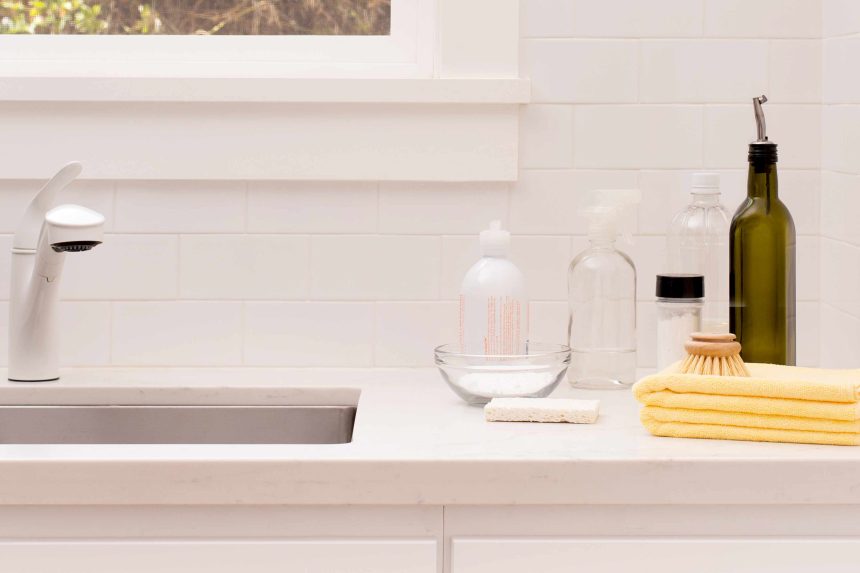Stainless steel sinks are one of the most popular types of sink, thanks to their affordability and durability. Long used in commercial kitchens for sinks and countertops, the steel contains chromium that provides corrosion-resistance and nickel that adds the brightness pure steel lacks. Unaffected by most household chemicals, these sinks will not rust and can be recycled into other metal items.
Stainless steel sinks have many qualities that make them a good option, but the minerals from hard water and improper cleaning can leave the sink with spots and streaks. With just a little time and effort, though, your sink can have the same shine you want in your stainless steel appliances.
How Often to Clean a Stainless Steel Sink
Kitchen sinks should be cleaned after each time they are used for food preparation to remove any bacteria and food particles that may linger on the surface. With regular daily cleaning, a deeper clean should only be needed about once a week. Laundry room and outdoor sinks should also be cleaned regularly.
Want more cleaning and organizing tips? Sign up for our free daily newsletter for the latest hacks, expert advice, and more!
The Spruce / Olivia Inman
How to Deep Clean a Stainless Steel Sink
Rinse Well
Using the faucet’s spray arm or a cup and hot water, start at the top of the sink and rinse away any residue on the sides and bottom of the sink. To clean the faucet, dampen the fixture with a cloth.
The Spruce / Olivia Inman
Coat With Baking Soda
Sprinkle dry baking soda on every surface including the faucet area. It should stick easily to damp surfaces. Baking soda is a gentle abrasive that will help remove stuck-on food and cut through greasy residue. It also acts as an odor remover to freshen the sink’s drain.
The Spruce / Olivia Inman
Scrub the Sink
Use a non-abrasive sponge or soft-bristled scrub brush to clean the sink in the direction of the metal grain. Brushed stainless steel sinks have faint lines or “grain” due to the manufacturing process. Always follow those lines to prevent additional scratches.
An old toothbrush works great for areas around the faucet or the sink’s edges. Don’t forget to clean in the drain opening. Do not rinse just yet!
The Spruce / Olivia Inman
Warning
Never use wire-bristled brushes, steel wool, or any type of abrasive scrubbing pad. The metal utensils can leave particles behind that can rust.
Spray With Vinegar and Rinse
After scrubbing with baking soda, spray the sink with distilled white vinegar (apple cider vinegar can also be used). You’ll begin to see some foaming action as the baking soda and vinegar react, so don’t worry. The acidity of the vinegar will help cut through mineral deposits that cause spots and streaks.
When the fizzing stops, rinse the sink and faucet area well with warm or hot water.
The Spruce / Olivia Inman
Dry and Check for Stains
Use a microfiber cloth to completely dry the sink and faucet. If stubborn stains remain like discoloration from water or food or rust from a utensil, they should be treated immediately.
The Spruce / Olivia Inman
Treat Tough Stains
To remove rust and other stains, create a paste of one-fourth cup cream of tartar (potassium bitartrate) and one cup of distilled white vinegar. Cream of tartar can be found in the baking section of the market and is used as a leavening agent and stabilizer. Cover the stained area with the paste, and rub it in with a sponge. Allow the paste to work for at least five minutes and then rinse it away. Repeat if needed.
The Spruce / Olivia Inman
Buff to a Shine
Once the sink is clean and dry, put a few drops of olive or coconut oil on a microfiber cloth and buff the sink and fixtures. The oil will make the stainless steel shine.
The Spruce / Olivia Inman
Tips to Keep Your Stainless Steel Sink Clean Longer
- Avoid using a dish mat in the sink. Debris gets trapped beneath the mat, making the sink harder to keep clean. Choose an open grid instead to protect delicate glassware.
- Always rinse away residual soap after cleaning dishes.
- Rinse and wipe down your sink after each use as a preventative measure.






